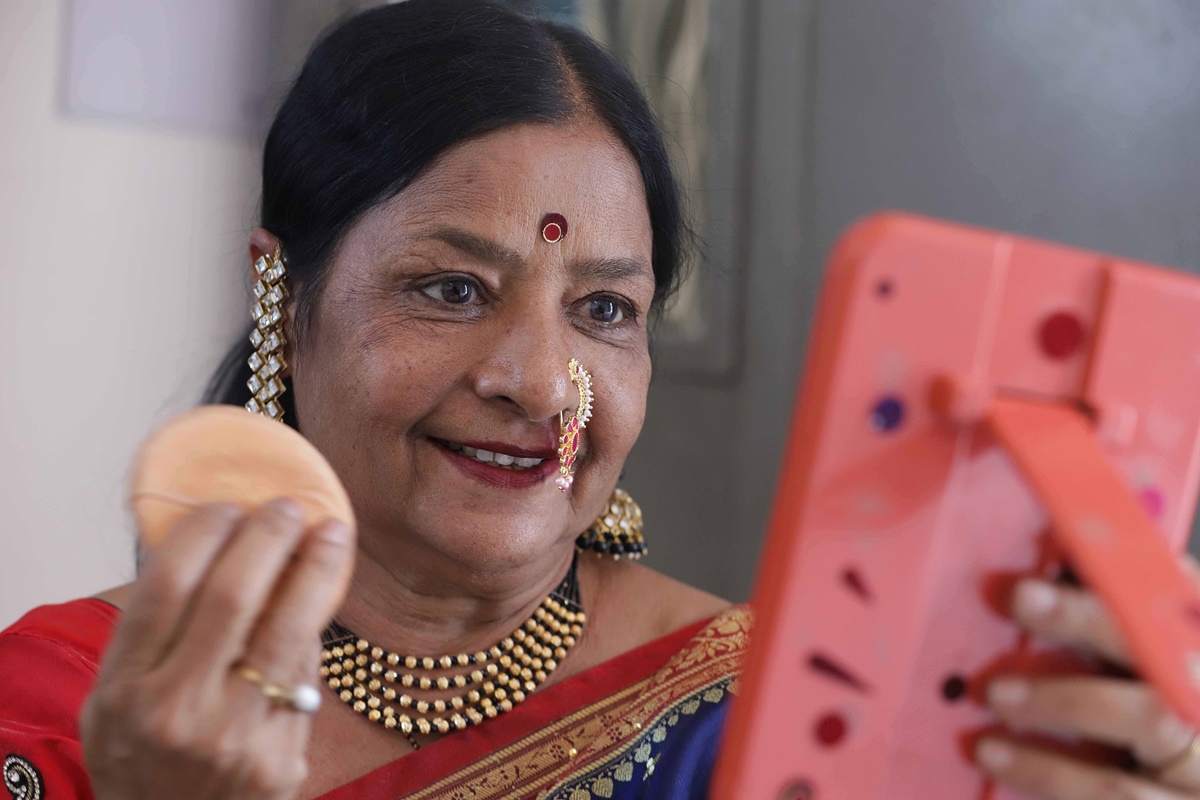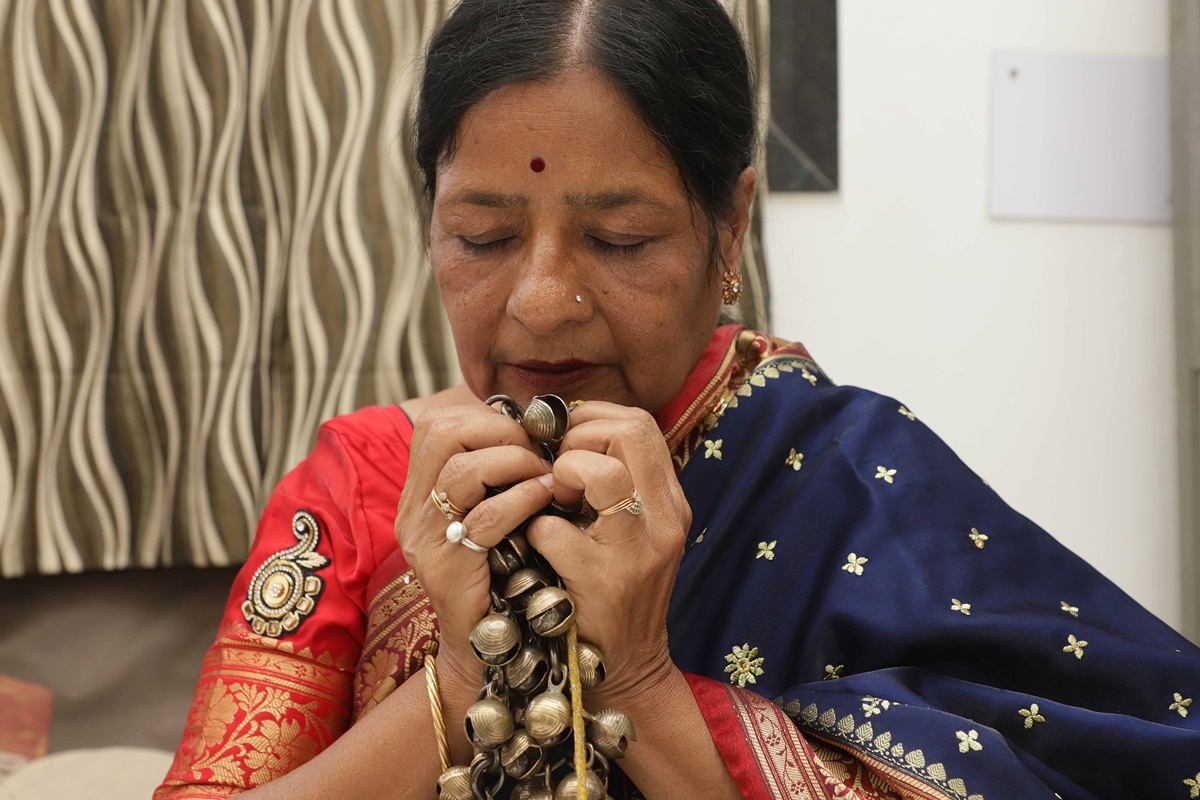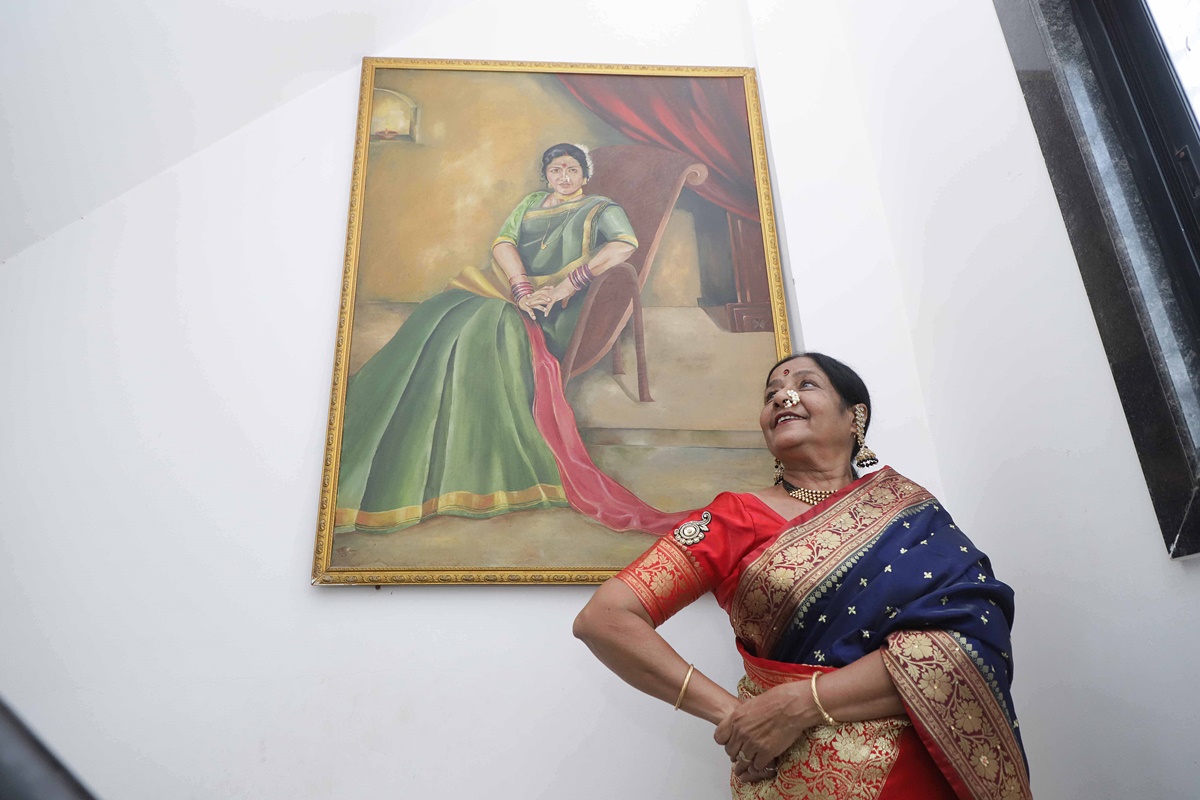[ad_1]
A few years ago, Pune-based Lavani dancer Shakuntala Bai Nagarkar was invited to perform at a concert in Delhi, where a classical dancer treated her like a lesser artist. Shakuntala did not let a single angry word escape her lips. She was given 30 minutes to perform but, an hour later, was still dancing and the audience was asking for more. It was another hour before the organisers could bring down the curtains. “Band bajane ka hai toh stage pe bajana hai. The classical dancer is an eminent artist but she made the mistake of disrespecting a folk performer,” she says.
Regarded as a Lavani queen in Maharashtra, Shakuntala, 63, is one of the last great dancers of a traditional form of Lavani called Sangeet Bari. She was presented with the Sangeet Natak Akademi award in 2009.
Lavani, whose name is drawn from the word lavanya or beauty, is an erotic dance form in which women, dressed in bright nine-yard saris, called nauvari, perform to songs with loaded meanings. The songs are, mostly, written by men for an audience of men. The themes range from politics to patriotism but have romance at the core.
Documented evidence dates Lavani to the 17th century, when travelling troupes set up platforms on open grounds and regaled large crowds in Maharashtra. Lavani remains an essential part of village fairs, alongside wrestling matches and Ferris wheels, but is also held in auditoriums. Shakuntala dances it in a flirty style, playful and teasing.
In recent years, Lavani has drawn flak for being raunchy. In February 2023, NCP leader Ajit Pawar issued instructions to his party workers against organising “vulgar and obscene” public performances under the guise of art. He was responding to a complaint by NCP member and Lavani dancer Megha Ghadge about the corruption of the dance by performers who wore revealing clothes, used obscene gestures and played DJ music. Sangeet Bari, in which women sing while dancing to the accompaniment of a dholki, tabla and paaypeti (harmonium), has been pushed to the fringe.
Shakuntala, too, lives on the outskirts. To meet her, one must travel away from Pune city to where furrowed fields heat in the sun. The dark and dry soil grows the hardiest of crops, such as millets. The road ends some distance away from Shakuntala’s house in a stretch of pebbles and earth that make an SUV sway. She likes the seclusion. “Society does not look upon Lavani dancers nicely. In city flats, neighbours are curious. I am seen on TV, so people know about me, but there are many Lavani artists who hide their identities to live in housing colonies,” she says.
In the living room, Shakuntala has hung a garlanded photograph of her mother, the Lavani dancer Chhabu Bai Nagarkar. It is under her gaze that she agrees to share her story. “Authors have approached me to write books about my life, but I have declined their offers. Padhta kaun hai? (Who reads?) People turn one or two pages and keep books aside. All folk performers dedicate their best years to art but never get recognised. Why should I be interested in telling the world about my life?” she asks.
Shakuntala belongs to a marginalised nomadic community, called Kolhati, which travels through villages, living in shacks and performing Tamasha theatre and Lavani. Shakuntala’s family had set down roots as farmers in Ahmednagar, where she was born in 1960. “My mother was the first woman in our family to go back to dancing,” she says. Lavani is a generational art form, with daughters taking after their mothers.
 The most important lesson was to look into people’s eyes, says Shakuntala Bai Nagarkari. (Express Photo By Pavan Khengre)
The most important lesson was to look into people’s eyes, says Shakuntala Bai Nagarkari. (Express Photo By Pavan Khengre)
From the beginning, Shakuntala would break into a jig if she so much as heard a jingle on a radio. She danced on her way to school. She won children’s competitions in dance and everybody showered her with gifts and affection. When Chhabu Bai started dancing at the historic Pila Haus or Play House theatre in Bombay in 1968, she sent Shakuntala to train with Kathak maestro Govind Rao Nikam. Chhabu Bai was followed by her younger sister and, then, her elder daughters, on stage. “After that, my number came. When I was in Class IV, my mother took me out of school. She said, ‘Can you read and write Lavani songs? That’s enough’. I was never ambitious but my mother believed that I would become a star,” says Shakuntala.
She wore her first pair of ghungroos in a theatre in Parali Vaijnath in Beed in 1971. Once a dancer accepts ghungroos, it is a symbol that she will never marry. This momentous occasion is not marked by ceremony or celebration. In 11-year-old Shakuntala’s case, it was her sisters who put her in a nauvari and ghungroos and sent her on stage. Lavani demands heavier ghungroos than Kathak or Bharatanatyam to suit its robust nature. Shakuntala’s first pair weighed two kg each. Over the years, the weight would keep increasing until she was dancing with 10 kg of tinkling bells on her feet.
The name Sangeet Bari — bari means “by turn” — comes from a music-and-dance show performed every evening at dedicated theatres. Sangeet Bari theatres employ five to six groups of women dancers, known as “parties”, who stay in the theatre and never step out without the permission of the theatre owner. Every evening, the parties take turns to perform before an audience. Each party gets 10-30 minutes. After the stage shows, men approach whichever party they liked for a baithak or private soirée so that they can enjoy the women’s performances intimately for an hour or two.
The price of a baithak — Rs 4,000 on an average at present — is divided between the party and the theatre owners. Dancers also receive tips on stage. The tips are collected and distributed among the dancers and the music accompanists. A desirable performer means a higher income for her party and the theatre. Shakuntala’s first tip was Re 1, which could buy a meal in the 1970s.
When Shakuntala joined a party at Hanuman Theatre, Lal Baug, Mumbai, in 1974, she became a disciple of Kathak guru, Vasantrao Ghatge. In the absence of a formal learning methodology, a Lavani dancer’s greatest education is watching others. “I used to have a lot of fun observing different Lavani dancers. I could imitate them same-to-same. The competition for audience attention made me learn more. The most important lesson was to look into people’s eyes,” she says.
Without a warning, Shakuntala makes eye contact. It is a direct stare filled with the promise of love that makes the heart skip a beat. “Unlike other dance forms, Lavani is characterised by powerful eye contact with the audience. The man thinks he is the god Indra and we are the apsaras. After the stage show, he comes to speak to us. We offer him paan or tea and ask if he wants to have a baithak with us. This is how we earn our livelihood,” she says.
 Shakuntala Bai Nagarkar was 11 years old when she wore the ghungroos for the first time (Express Photo By Pavan Khengre)
Shakuntala Bai Nagarkar was 11 years old when she wore the ghungroos for the first time (Express Photo By Pavan Khengre)
The euphemisms and metaphors that enrich Sangeet Bari do not extend to describing men. They are, simply, the customers. If he makes a farmaish (request) for a song that the dancer does not know, she loses an income. The customer will move to another dancer. From classical and film songs to bhavgeet and bhajans, Shakuntala mastered them all. Sometimes, it was old customers who taught her rare Lavani songs or corrected her abhinaya. Like her mother, Shakuntala also had a powerful singing voice. Men were coming from far to see her—one man in particular.
In Sangeet Bari, there are no boyfriends or lovers. The women mingle with customers and “build connections”, who are called malik or master. Shakuntala’s first connection had no love. He kept coming to her shows for a year and gave her everything she asked for, from gold and silver to clothes and money. “What else could a girl want?” she says. He spoke to her sisters and she went with him. He was married and a father of two.
Shakuntala was happy to be pregnant. Dancers give birth to children when and with whom they want. If there are two or more customers, they decide whom to encourage. Some customers are crooks or worse and best avoided. The children carry their mother’s surname. “The father may be interested or not, it does not matter to us. We don’t depend on them. It has happened that a customer, who is the father of my child, gets attached to another dancer. Hum aadmi logon ka tension nahin lete (We do not stress about men),” says Shakuntala. She enjoys wearing sindoor, because why not, and wanted children early so that she would be young as they grew up. Before every delivery, she went home to Ahmednagar to eat well and become healthy.
Shakuntala has two daughters and a son. The arrival of a girl calls for celebration; Shakuntala distributed pedas all around. “In our art, it is the girls who earn. Boys don’t do anything. Mostly, they sit and eat,” she says. She kept her children in Ahmednagar, to be brought up by her brother and his wife. She sent money for their upkeep but suffered the pain of being far from them. “I never got to celebrate their birthdays. Today, my children have grown up but I make sure to celebrate all their birthdays,” she says.
In 1993, Shakuntala won a prestigious Lavani competition organised by the state government in Akluj, Solapur. In 1996, however, she hung up her ghungroos and went home to be a mother.
The sabbatical lasted a year. Shakuntala missed performing. She joined a party, which she owned with her sisters in Solapur, but quit in 1997. It is in the next phase that the dancer has performed some of her greatest works. She never went back to a Sangeet Bari theatre, choosing to stay home and work in plays based on Sangeet Bari culture instead. She did 100 shows of the play Sakhi Mazi Lavani (1998), with the doyen Madhu Kambikar. In 2002, she delivered another hit, Rangi Rangala Lokarang, with Keshavrao Badage, a Sangeet Natak Akademi-winning music accompanist. “I felt irresistibly drawn towards the old Sangeet Bari songs of Shahir Sagan Bhau, Patthe Bapu Rao and Ram Joshi. I honed the nazuk adakari of dancers like my mother, Yamuna Bai Waikar and Roshan Bai Satarkar,” she says.
 Lavani, drawn from the word lavanya or beauty, is an erotic dance form performed by women in bright nine-yard saris. (Express Photo By Pavan Khengre)
Lavani, drawn from the word lavanya or beauty, is an erotic dance form performed by women in bright nine-yard saris. (Express Photo By Pavan Khengre)
In the Marathi book, Sangeet Bari, Bhushan Korgaonkar writes, “I once watched Shaku Bai perform the Lavani, Tujha ra naahi honaaar kalyaan (You will not come to any good), in which the female protagonist is cursing the man who has been unfaithful to her. She played it so powerfully that even the men in the audience, who had never betrayed a woman, began to feel shame and guilt.” Shakuntala was invited to perform at the Bharat Rang Mahotsav, organised by the National School of Drama in Delhi, in 1999, and was part of an ICCR-organised festival of India in Cairo, Egypt, in 2003. She brought home so many trophies that most of them are now kept in a drum on the terrace of her house.
Around 2000, the old ways began to fade. A different kind of Lavani has now become popular, by dancers such as Gautami Patil who has been a viral sensation since a video captured her making an obscene gesture at a show last year. Unlike most veterans, Shakuntala does not attack Patil. “She does not even wear ghungroos, but that’s her choice. There is an audience that likes her,” she says.
Evening shows are still held at Sangeet Bari theatres but the quality of dancing has fallen. When Shakuntala visits the 90-year-old Aryabhushan Tamasha Theatre, an important Sangeet Bari space, in Ganesh Peth, Pune, the young dancers don’t even look up from their phones, uninterested in the icon in their midst. “The new girls don’t care about working hard like us. They are more interested in earning a quick buck at commercial or ‘banner’ shows. Even the modern customer has no knowledge,” says Shakuntala. There are instances of audiences misbehaving with dancers, whose only security are the few men who work in the theatre. Police are called in extreme cases. Neither of Shakuntala’s daughters has followed in her footsteps.
Korgaonkar, a Mumbai-based writer, director and theatre producer, is among those making an attempt to keep Sangeet Bari alive for future generations. “The dancers are often seen as manipulative women who break families. But, they are themselves discriminated by gender, class and caste, and are posing a fundamental challenge to patriarchy,” he says. Korgaonkar has directed two plays on the art form, Lavani ke Rang and Love and Lavani, both featuring Shakuntala.
In March 2023, Lavani ke Rang was shortlisted for one of India’s biggest theatre competitions, the Mahindra Excellence in Theatre Awards. Shakuntala emerged as the winner in the Best Actor in Lead Role (Female) category. All her life, she had wanted to be seen. At the glittering awards ceremony, as a packed Kamani auditorium in Delhi echoed with applause, Shakuntala mumbled through her tears. It was, perhaps, the only time Shaku Bai could not seduce the stage. “Sangeet Bari can come alive again but you need somebody to light the fire and keep it burning,” she says, later.
Soon after the pandemic started, Shakuntala was diagnosed with cancer of the lung. It was the disease that had taken her mother. Shakuntala has been through 14 chemotherapy sessions. “I had two conditions for the doctor —- I did not want to lose my hair and I did not want to stop performing,” she says. Shakuntala did not cancel a single show and her tresses stayed lovely. “Fear is the biggest disease. I never want to be afraid. I want to spend whatever time I have being happy and making others happy. I have told my cancer, ‘As long as you are inside me, you will have to dance with me,’” she says. In her bedroom, she keeps a suitcase packed with a nauvari, make-up, jewellery, ghungroos and the pills she must take every day.
[ad_2]










